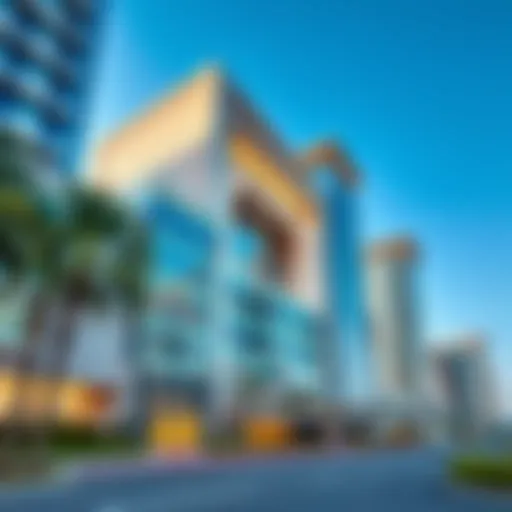Exploring Malls in Dubai: A Comprehensive Analysis


Intro
Dubai, a city often associated with luxury and innovation, stands as a global hub for ambitious architectural feats and retail extravagance. The sprawling shopping malls serve not only as commercial centers but also as social epicenters where cultures converge. Among these concrete giants, the shopping malls exemplify the unique characteristics of Dubai's landscape, making them noteworthy in the realms of architecture, commerce, and community living.
In this exploration, we will delve into the intricate tapestry of malls that dot the Dubai skyline. From the iconic Dubai Mall, known for its vast array of shops and entertainment options, to the more localized charm of the Ibn Battuta Mall, each venue brings its own flavor to the retail scene. Understanding these malls' contributions can provide valuable insights for investors, homebuyers, and real estate enthusiasts regarding property values and lifestyle choices.
Shopping centers do not merely cater to consumer needs; they embody the social fabric of Dubai. Here, families create memories, friends gather, and entrepreneurs thrive in a vibrant economy. Through a thorough analysis, we will uncover how proximity to these retail hubs influences not only real estate dynamics but also the preferences and habits of residents.
Without further ado, let’s navigate the market trends shaping the mall landscape in Dubai.
Prelims to the Mall Culture in Dubai
The mall culture in Dubai is not just about shopping; it is a reflection of the city's identity and social fabric. For residents and visitors alike, these sprawling retail spaces serve as vibrant gathering spots, offering a diverse range of activities, entertainment options, and culinary experiences. Malls here are an integral part of everyday life, influencing everything from social interactions to economic dynamics.
When exploring the significance of malls in Dubai, there are a few key elements to consider. First off, these mammoth retail centers cater to a variety of lifestyles, accommodating both local traditions and international tastes. Whether it’s high-end brands or local boutiques, there is a little something for everyone. This inclusivity speaks volumes about Dubai's aspiration as a melting pot of cultures.
Another important consideration is the sheer scale of investment in mall infrastructure. With projects like The Dubai Mall and Mall of the Emirates, investors have recognized the potential of these spaces not just as retail hubs but as complete lifestyle environments that blend shopping, dining, and entertainment. This booming mall culture also contributes to job creation and boosts local economies.
The following sections will provide a detailed overview of this unique shopping lifestyle, tracing its historical roots and examining how it has evolved over time. By delving into the specifics, we aim to arm investors, homebuyers, and casual readers with insights necessary to understand the importance of mall proximity when making property decisions in Dubai.
Overview of Shopping Lifestyle
In Dubai, shopping transcends the act of purchasing goods; it has morphed into a lifestyle choice. Residents and tourists flock to malls not only to shop but to socialize, dine, and experience entertainment. Walk into a mall, and you are met with high ceilings, lavish designs, and a myriad of activities: from ice skating rinks to aquariums filled with exotic fish.
This shopping lifestyle also reflects regional cultural nuances. For many locals, visiting a mall on weekends is akin to going out for coffee; it is a shared social experience. Families often plan their weekends around mall activities, making them an essential element of community bonding. Moreover, seasonal festivals and promotions further enrich this lifestyle, encouraging visitors to explore new stores and events.
Historical Context of Malls
The inception of malls in Dubai can be traced back to the 1990s, coinciding with the rapid economic growth of the United Arab Emirates. Before that, local markets known as souks were the primary shopping destinations. However, as the city started to evolve into a global trade hub, the shift towards modern shopping complexes became inevitable.
The first notable mall was the Al Ghurair Centre, opened in 1981, but it was the introduction of more ambitious projects in the 2000s that truly transformed the landscape. The Dubai Mall, which opened in 2008, marked a turning point. Not only is it one of the largest malls in the world, but it also features cultural and entertainment attractions that redefine the shopping experience.
Today, malls encapsulate both the luxurious lifestyle that Dubai promotes and the local essence, melding tradition with modernity. It's a historical evolution that allows newcomers to appreciate how far the city has come, emphasizing the pivotal role malls play in the ongoing narrative of Dubai's urban development.
"Malls in Dubai are more than shopping spaces; they are community hubs that bring people together."
Their histories and architectural marvels are testaments to how retail adventure is woven into the tapestry of life in this vibrant city. Understanding this context sets the stage for a broader discussion about the architectural ingenuity and cultural significance of Dubai's major shopping destinations.
Architectural Marvels of Malls
The malls in Dubai are more than just retail spaces; they are testaments to modern engineering and design prowess. Each mall showcases unique architectural features that not only captivate visitors but also reflect the cultural ethos of the emirate. In a city known for daring designs, these shopping centers embody innovation, aesthetic appeal, and thoughtful planning that cater to both functionality and experience.
Modern Designs and Aesthetics
Contemporary malls in Dubai exhibit an array of stunning modern designs that push boundaries. The aesthetic of a mall can significantly influence consumer attraction and retention. For instance, the Dubai Mall, with its mesmerizing water features and expansive spaces, draws thousands daily, not just for shopping, but also for leisure and entertainment. The blend of glass and steel creates a sense of openness, encouraging visitors to explore every nook and cranny.
- Unique Elements: Details like atriums, art installations, and natural lighting are strategically incorporated. These elements not only beautify the ambience but also improve the overall shopping experience, making it less sterile and more inviting.
- Architectural Styles: Different malls feature varied design styles. The Mall of the Emirates’ dome and intricate patterns speak to Islamic architecture, while Ibn Battuta Mall echoes a historical theme, with each section reflecting a different culture. Such diversity in design helps to capture the spirit of the global community present in Dubai.
Sustainability Efforts in Mall Designs
Sustainability in architecture is becoming a focal point, especially in a region where environmental considerations are paramount. Malls in Dubai are emerging as models of sustainability by integrating eco-friendly technologies and practices into their designs.


The Dubai Mall has been recognized for its efforts in reducing carbon footprints. Key sustainability initiatives include:
- Energy-Efficient Systems: From solar panels to energy-efficient lighting, malls are increasingly focusing on reducing energy consumption.
- Water Conservation: Rainwater harvesting systems and water-efficient fixtures help in significantly lowering water waste.
- Material Choices: The use of sustainable materials in construction, such as recycled metals and locally-sourced stone, minimizes environmental strain.
"Malls now play a dual role as shopping destinations and eco-conscious spaces, transforming how we perceive retail environments," says a leading architect involved in mall design in Dubai.
Incorporating these design philosophies not only enhances the brand image of malls but also attracts environmentally conscious consumers, providing them with a space that aligns with their values. As we look towards the future, the blend of exquisite design and sustainability will undoubtedly continue to shape how malls evolve in the dynamic marketplace of Dubai.
Major Shopping Destinations
The significance of shopping malls in Dubai extends far beyond mere retail outlets. They have evolved into integral parts of the city’s identity, serving as venues for leisure, social interaction, and cultural experiences. This section explores the major shopping destinations, illustrating their unique offerings and cultural implications, and how they contribute to the economic landscape of the emirate. Understanding these shopping locales can provide valuable insights for potential investors and homebuyers regarding property values and lifestyle choices.
The Dubai Mall: A Benchmark
The Dubai Mall stands as a paragon of luxury and modernization, stretching a whopping 1.1 million square meters. It's not just about shopping; it's an entire ecosystem where entertainment and dining intersect with commerce. Aside from over 1,200 retail stores, the mall houses attractions like the Dubai Aquarium & Underwater Zoo, which offer visitors a glance at marine life relatively unseen in mall environments.
Moreover, The Dubai Mall’s prime location, adjacent to the Burj Khalifa, boosts its appeal not just for tourists but also for residents. It's a bustling hub where the social atmosphere buzzes day and night.
“It’s not merely a shopping destination; it's a lifestyle statement for many.��”
In terms of property value, having proximity to The Dubai Mall can significantly enhance real estate investments, as nearby homes are seen as more desirable for both renters and buyers.
Mall of the Emirates: Beyond Shopping
The Mall of the Emirates offers a unique blend of shopping and leisure, highlighted by the famed indoor ski slope, Ski Dubai. Shoppers here are not just seeking goods, but also experiences. The presence of a cinema, a family entertainment center, and various dining options makes it a family-friendly destination.
For potential homebuyers, this mall represents more than retail. The local real estate market often mirrors the vibrancy of the mall. Living close to the Mall of the Emirates can provide easy access to leisure activities, which is a big draw for families and young professionals alike. This enhances the property’s attractiveness and could lead to better market prices.
Ibn Battuta Mall: A Cultural Journey
Ibn Battuta Mall offers a different flavor, drawing its themes from the travels of the famous explorer. Each section of the mall is dedicated to a different region of the world, from Asia to Africa. This unique design not only influences shopper engagement but also fosters a sense of global community.
As potential investors consider nearby properties, it’s crucial to recognize that the cultural representation here goes beyond enertainment; it creates a deeper bond with the local community. The story behind the mall adds value, attracting residents who appreciate cultural diversity.
Dubai Festival City Mall: Entertainment Hub
Dubai Festival City Mall serves dual purposes: it’s shopping galore and a family entertainment haven. With a vast array of restaurants, a cinema, and the impressive IMAGINE show—a mesmerizing display of light and water—this mall embraces the concept of an entertainment hub.
The unfolding amenities here also suggest a positive outlook for real estate in the vicinity. Homes located near this mall benefit from its integrated lifestyle offerings, attracting families looking for convenience and leisure. With ongoing developments nearby, the property values are poised for growth as the demand from both residents and tourists continues to swell.
In summary, these major shopping destinations are not just about retail; they embody the essence of Dubai’s cosmopolitan lifestyle. For potential homebuyers, understanding the significance of these malls can help make informed decisions about the value and appeal of nearby properties.
Impact of Malls on Real Estate
The influence of malls on real estate in Dubai is a subject that warrants thorough exploration. As urban centers grow, malls become more than just shopping venues; they transform into multifaceted ecosystems affecting property values, community dynamics, and lifestyle choices. In this section, we will delve into how these retail spaces play a pivotal role in shaping the real estate landscape of the city.
Property Value Considerations
Malls have a direct impact on property values in their vicinity. Properties located near shopping malls tend to see a significant appreciation in value compared to those that are farther away. One main reason for this is the accessibility and convenience that malls offer. Having a major shopping center nearby can be a game-changer for prospective homeowners.
When evaluating property, buyers often weigh the proximity to amenities like malls heavily. A home that is just a hop, skip, and jump away from a well-frequented mall not only becomes more appealing but also commands a higher price tag. The perceived value stems from the variety of services available in malls—everything from grocery shopping to entertainment. This creates a lifestyle that aligns well with the modern urbanite.
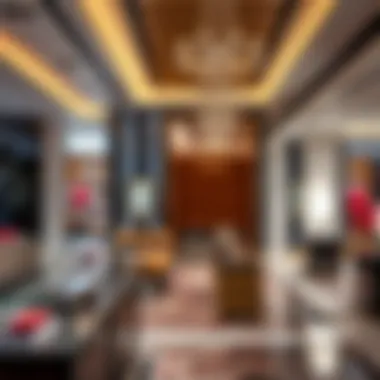
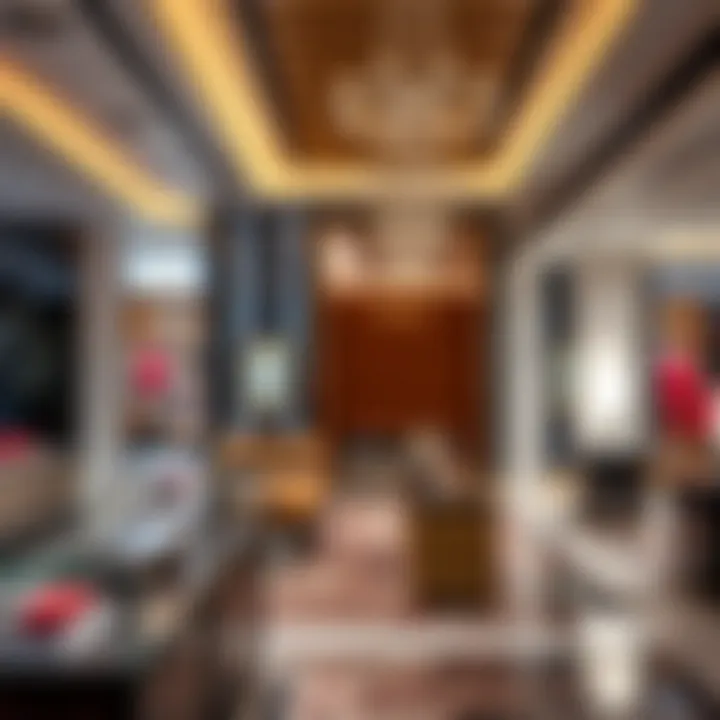
Some key considerations for potential investors include:
- Market Trends: The presence of a mall may indicate a growing area, which often leads to increasing property demand.
- Rental Income: Properties near malls can command premium rental rates, resulting in attractive returns for landlords.
- Resale Value: Malls often sustain their relevance and draw consistently, ensuring that homes nearby retain their resale value.
"In a bustling city like Dubai, living near a mall is akin to having golden real estate. It’s not merely about convenience; it’s an investment in lifestyle and future gains."
Living Proximity to Retail Spaces
The proximity to retail structures like malls can significantly influence where people decide to settle down. Malls are more than just retail outlets; they serve as social hubs where residents can gather for both shopping and entertainment. Families are particularly drawn to areas that feature such recreational spaces, making these communities desirable.
Living near malls offers several benefits that range from practical to social:
- Accessibility: Having a variety of stores and services within a stone's throw means less time spent on the road and more time enjoying life.
- Community Interaction: Malls often host events, attracting local residents and fostering a sense of community—a vital consideration for families looking for a neighborhood that offers social engagement.
- Lifestyle Choices: The ease of access to diverse eateries, leisure activities, and shopping means residents can enjoy a vibrant lifestyle that matches their preferences.
Investors must understand that amenities enhance a property’s profile, making it appealing not only to buyers but also to renters. In a competitive market like Dubai, where luxury apartments and high-rise buildings loom large, being a stone's throw from a bustling mall can make or break a property's desirability.
Social and Cultural Significance
In Dubai, shopping malls serve as more than just retail destinations; they embody a vibrant social and cultural landscape that shapes the lives of residents and visitors alike. These spaces are not merely spots for consumer transactions; they play a crucial role in fostering community interaction and reinforcing local identity. As the city rapidly evolves, understanding the social and cultural significance of malls becomes essential to grasping the broader context of urban life in Dubai.
Malls as Community Centers
Dubai's malls have transformed into lively hubs where people from diverse backgrounds come together. They offer a unique blend of shopping, entertainment, and socialization that can hardly be found in other urban environments. Malls like The Dubai Mall and Mall of the Emirates create an atmosphere that encourages connections among individuals, families, and friends.
- Events and Activities: Malls frequently host various community events, from cultural festivals to seasonal celebrations. These gatherings provide opportunities for local artists, musicians, and performers to showcase their talents. They help cultivate a sense of belonging and community spirit, bridging cultural gaps and promoting inclusivity.
- Cafés and Dining Experiences: The presence of diverse dining options within malls enhances the social aspect. Whether it’s a quick bite or a leisurely meal, food serves as a medium for gathering. Families often choose these vibrant spaces to share meals, creating memories that bind them together.
- Spaces for Conversation: Malls often feature lounge areas and open spaces where people can pause and chat. This casual setup fosters casual interactions, allowing individuals to meet new people or reconnect with friends.
Malls in Dubai are not just shopping centers; they are the heartbeat of the community, pulsing with life, culture, and connection.
Influence on Local Culture
The impact of malls on local culture in Dubai is profound and multifaceted. They reflect the city's rich diversity while shaping the way residents experience community life. The way malls integrate various cultural elements promotes cross-cultural exchanges and a broader acceptance of different lifestyles.
- Cultural Representation: Malls feature art installations and exhibitions that echo the heritage of the UAE. These displays help residents and tourists alike to engage with local culture, fostering an appreciation for the artistic expressions that define the Emirati experience.
- Commercialization of Tradition: While many might argue that malls dilute traditional customs, they also create avenues for celebrating local customs through themed events or festivals. This blend of old and new presents a unique landscape where traditional craft fairs coexist with international brands, enabling a cultural dialogue.
- Consumer Behavior: The preferences of consumers in malls can reflect shifting cultural attitudes. The way products are marketed and sold can indicate broader societal values, nudging local businesses to adapt and innovate. This constant evolution feeds back into the local culture, reinforcing or even altering community norms.
In essence, Dubai's malls are pivotal in shaping both social interactions and cultural narratives. As the landscape continues to develop, recognizing their significance will be vital for anyone invested in the region's real estate or lifestyle dynamics. Effective utilization of mall spaces can lead to vibrant community interactions, making them integral to understanding the fabric of Dubai's urban environment.
Economic Contributions of Malls
Malls are much more than just shopping avenues; they serve as vital economic engines for Dubai. By dissecting their contributions, we can uncover how these retail giants influence local economies, create jobs, and attract tourists. The economic fabric of Dubai is tightly interwoven with the existence and success of its malls, making this analysis particularly relevant for investors and homebuyers alike. With global attention shifting to Dubai as a shopping haven, understanding the economic aspects of these malls becomes crucial in grasping their broader impact on the city’s prosperity.
Job Creation and Employment
The role of malls in job creation is significant. With their extensive retail spaces, food courts, and entertainment options, shopping centers provide thousands of employment opportunities, from part-time positions to managerial roles. Every major mall creates a chain reaction of jobs: retail staff, security personnel, cleaning crews, and even local artisans who sell their crafts in stores or at special events.
The sheer volume of employment generated is staggering. For instance, The Dubai Mall alone is home to over 1,300 retail outlets which means thousands need to be hired to keep the daily operations running smoothly. Furthermore, the mall's management requires teams focused on marketing, events, and customer service. These job openings draw in people from various backgrounds, contributing to a diverse workforce that reflects the multicultural fabric of the city.
- Benefits of job creation in malls include:
- Increased consumer spending as newly employed locals get disposable income.
- A boost to surrounding businesses—local shops, restaurants, and services often see increased traffic thanks to mall operations.
- Enhanced community engagement through jobs related not just to sales but also to service and entertainment sectors.
Tourism and Global Appeal
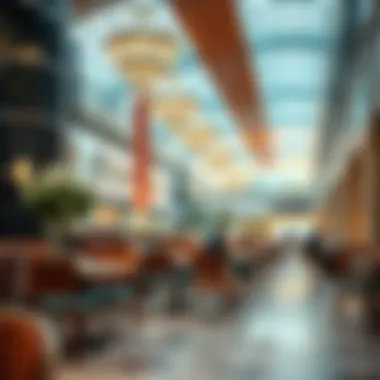
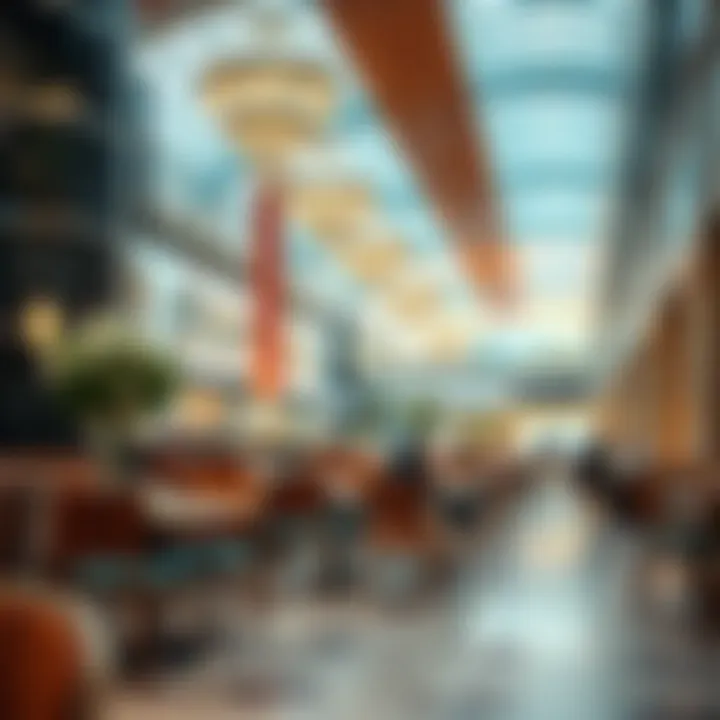
The economic contributions of malls extend beyond local job creation; they also play a crucial role in attracting tourists. Dubai's malls are not only retail destinations but also tourist attractions in their own right. For instance, visitors flock to The Dubai Mall not just to shop but to experience the aquarium, ice rink, and other entertainment options. The combination of shopping, dining, and leisure activities makes these malls a key part of Dubai's tourism strategy.
The statistics speak volumes. According to Dubai’s Department of Tourism and Commerce Marketing, the city attracts millions of visitors each year, many of whom prioritize shopping as a key activity during their stay. Malls like Mall of the Emirates, with its indoor ski slope, and Ibn Battuta Mall, which offers a cultural journey through its themed sections, enhance Dubai’s reputation as a global shopping hub. It’s this global appeal that drives tourism revenue, bolstering the local economy even further.
"Malls in Dubai are not merely places where goods are exchanged; they have evolved into vibrant ecosystems that fuel job creation and attract a global audience."
Future Trends in Mall Development
The evolution of shopping malls in Dubai reflects broader shifts in consumer behavior, technological advancements, and economic conditions. Understanding the future trends in mall development is not just relevant for investors and homebuyers but crucial for anyone who wishes to navigate the dynamic landscape of retail spaces in this vibrant city. As societal needs and preferences continue to change, so will the framework that supports retail environments.
Evolving Consumer Preferences
Today's shoppers are not just looking for products; they want experiences. This shift towards experiential shopping is a game changer in the way malls are designed and function. Consumers, particularly the younger generation, seek interactions that go beyond mere purchases. They want spaces that foster connections, adaptability, and entertainment. For instance, a trip to a mall might now include dining at a rooftop restaurant, attending workshops, or even joining wellness classes.
Key Considerations:
- Experience Over Product: Malls are making significant changes to their layouts, prioritizing open spaces where events can take place. This means there are less and less shops squeezed into every corner.
- Diversity of Offerings: Beyond traditional retail, many malls now incorporate art galleries, stages for live performances, and areas designated for pop-up shops to keep the offering fresh and engaging.
- Community Integration: Malls are further embedding themselves into the community’s fabric, creating spaces where local culture and identity can be celebrated. You might find a mall hosting local artisan markets or weekend movie nights that attract families.
In essence, malls must adapt to serve as multi-functional spaces, catering to the leisure and lifestyle desirers of their patrons. This cultural pivot underscores the necessity for developers to consider how their projects can foster a sense of community and belonging.
Integration of Technology in Retail
As technology seeps into every aspect of our lives, it naturally finds its way into malls, reshaping the shopping experience. The integration of sophisticated technologies in retail not only streamlines operations but also enhances the consumer journey, making it seamless and personalized.
Notable Technology Trends:
- Augmented Reality (AR): Consumers may soon use AR apps to visualize how furniture from a store looks in their homes before making a purchase. Imagine pointing your phone at a table and seeing it superimposed in your living room!
- Mobile Payment Solutions: Curbing the bottle-neck at checkout queues, mobile payments are becoming mainstream. Consumers appreciate the efficiency and ease of simply tapping their phones rather than fumbling with cash or cards.
- AI and Personalization: Retailers utilizing AI can analyze shopping patterns to offer personalized suggestions, enhancing the shopping experience. Think of it as your personal shopping assistant, guiding you through the intricate maze of products tailored to your tastes.
Key Benefits:
- Convenience: These technologies make shopping easier, which likely leads to higher consumer satisfaction and increased spending.
- Data Insights: Mall operators can collect valuable data about foot traffic and consumer preferences, enabling more informed decisions regarding retail spaces.
- Engagement: Interactive displays and kiosks can foster a sense of novelty, keeping customers engaged and encouraging them to spend more time in the mall.
Investing in technology doesn’t merely improve operations; it also attracts consumers who thrive on innovation and interaction.
In summary, the future of mall development in Dubai is being shaped by a blend of changing consumer preferences and the relentless march of technology. Developers and investors alike must remain vigilant, staying ahead of the trends that not only enhance shopping experiences but also resonate with what shoppers truly desire in their environments.
End: The Future of Malls in Dubai
In the heart of Dubai's bustling economy and vibrant culture, the role of malls is shifting, reflecting the changes in consumer behavior. As the landscape of retail transforms to adapt to the digital age, understanding these dynamics is crucial for various stakeholders. Malls in Dubai are not just shopping destinations; they are evolving into multi-purpose complexes that blend retail, entertainment, and social interaction. This evolution presents numerous opportunities and challenges for investors, homebuyers, and urban planners alike.
Summary of Key Insights
Through this exploration, several key insights emerge about the future of malls in Dubai:
- Changing Consumer Habits: Today’s shoppers are looking for experiences rather than just products. Malls are becoming social hubs with features like themed entertainment, art installations, and wellness options, driving foot traffic.
- Integration of Technology: With advancements in technology, there’s a move towards smarter malls, incorporating elements like augmented reality and personalized shopping experiences.
- Sustainability Initiatives: As awareness of environmental issues rises, malls are focusing on sustainable practices, such as energy-efficient designs and supporting local artisans, which can elevate their appeal to eco-conscious consumers.
- Diversified Offerings: Beyond traditional shopping, malls now include residential spaces, offices, and even healthcare services. This diversification provides a comprehensive lifestyle offering that residents find attractive.
These insights illuminate the pathways for the development of malls in Dubai, emphasizing the need for adaptability and innovation.
In an ever-evolving market, staying ahead means embracing change and recognizing that malls must meet the varied needs of their communities.
Implications for Investors and Buyers
For investors and buyers, the shifting landscape of malls poses significant implications. Understanding the trends can dictate sound investment strategies:
- Investing in Mixed-Use Developments: There's a growing preference for properties that incorporate retail, living, and leisure spaces. Investments in such developments can harness high demand and increased property values.
- Focus on Location: Proximity to desirable malls can influence property values. Buyers should pay close attention to developments around major malls to gauge potential investment opportunities.
- Emphasizing Customer Experience: Investors should consider facilities that enhance the shopper experience, such as child-friendly spaces, lounges, and recreational areas to attract foot traffic.
- Engaging Local Communities: Malls that foster community interactions, like hosting local events or farmer’s markets, are likely to thrive, creating a loyal base of shoppers.
Overall, as the future unfolds, understanding these dynamics will empower investors and buyers to make informed decisions. The continued evolution of malls in Dubai represents not just a shift in retail but also a reimagining of urban life.















